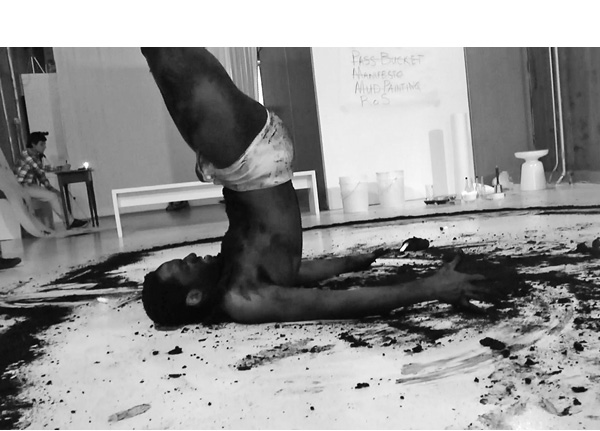
1ST AMERICAN SHAPIST HOUSE FOR THE PRACTICE OF PERFORMANCE /RITUAL
first performed on April 13, 2013
Defibrillator Performance Art Gallery, Chicago, IL
performed once in 2013
WHITNEY HUNTER
David LaGaccia
New York, NY
whitneyhunter.com
1ST AMERICAN SHAPIST HOUSE FOR THE PRACTICE OF PERFORMANCE /RITUAL
WHITNEY HUNTER
1ST AMERICAN SHAPIST HOUSE FOR THE PRACTICE OF PERFORMANCE / RITUAL
“1st American Shapist House for the Practice of Performance/Ritual” is a performance/installation experimenting with process, presence and intention. Through this six-hour process, I tested my physical, psychological and emotional depths, the willingness of the viewer and the fortitude of the space itself. The work was inspired by a continued investigation into the practice of spirituality or act(s) associated with spiritual endeavor and the synonymity of art and spirituality.
“1st American Shapist House” is also concerned with the consecration of neutral space (e.g., store front churches, basements in homes, etc.). The art gallery is a place invested in the presentation of artistic and aesthetic rigor—a space concerned with the personal exploration of an idea through artistic means. Is there a consecration that occurs within an art gallery at the hand of the artist, curator or other?
The space is transformed from a neutral white box to a ritualized ceremonial site. The initial actions—sifting through earth and extracting foreign objects, inviting the audience to place handfuls of earth in the center of the space, creating mud paintings to be hung on the wall as iconographic imagery—all worked to alter the physical space of the gallery.
Documenting the performances was a collaborating journalist taking notes on my actions throughout each six-hour performance. Before the first performance, he conducted an interview with me that looked at my expectations for the first performance. After I finished my second six-hour durational performance, he interviewed me again, reflecting on our reactions.
This documentation was an investigation of documentation or archive as a medium. This idea is being explored by other contemporary artists and cultural institutions and is of great interest to me. However, from this investigation the question arises, “Is there an expectation to concretize ephemeral performance through documentation?”
The work of my collaborating journalist is an exercise of one of the Shapist principles: “expand the boundaries.” Test the abilities of text to instigate a sensual response similar to responses triggered by perceptible actions.